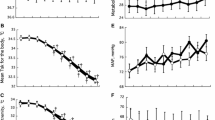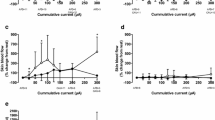Abstract
We have studied responses evoked in the forearm vasculature of twelve subjects with homozygous sickle cell disease (SS) and in eight dark-skinned controls of West Indian ancestry (AA) by mild cooling of the contralateral hand in water at 16°C for 2 min; this stimulus was repeated six times at randomized time intervals. Total forearm blood flow was measured by venous occlusion plethysmography, cutaneous red cell flux was monitored by a laser Doppler flowmeter and arterial pressure was recorded by semi-automatic sphygmomanometry. Of the AA subjects, three showed a decrease in total forearm vascular resistance (FVR, of -10%) in response to the first immersion and this reversed to an increase in FVR (+7%) by the sixth immersion. The remaining five showed an increase in FVR (+65%) which persisted until the sixth immersion (26%). By contrast, all SS subjects showed an increase in FVR (+32%) which persisted to the sixth stimulus (+27%). Further, on a scale of discomfort of 0–10, none of the AA subjects rated the cool stimulus higher than 0, whereas SS subjects gave a rating of 7 for the first stimulus which decreased to 5 by the sixth stimulus. Both AA and SS subjects showed an increase in arterial pressure and a tendency towards vasoconstriction in forearm skin. We propose that, as in Caucasian AA subjects, dark-skinned AA subjects showed a primary reflex vasoconstriction in forearm muscle in response to mild, indirect cooling which was overcome in some individuals by muscle vasodilatation of the alerting response that is evoked by novel or noxious stimuli. By contrast, in SS subjects, such muscle vasodilatation was not able to overcome the strong reflex vasoconstrictor response to cooling despite the perceived unpleasantness of the stimulus. The significance of these findings is discussed in relation to the initiation of painful crises in SS subjects.
Similar content being viewed by others
References
Serjeant GR.Sickle Cell Disease. Oxford: Oxford University Press.
Redwood AM, Williams EM, Desai P, Serjeant GR. Climate and painful crisis of sickle cell disease in Jamaica.Br Med J 1976:i: 66–68.
Amjad H, Bannerman RM, Judisch JM. Sickling pain and season.Br Med J 1974;i: 54.
Addae SK. Mechanism for the high incidence of sickle cell crisis in the tropical cool season.Lancet 1971;ii: 1256.
Ratner SJ, Athanasian EA. Water sports and sickle cell anaemia.Arch Intern Med 1986;105: 971.
Higgs DR, Aldridge BE, Lamb J, Clegg JB, DJ, Hayes RJ, Grandioson Y, Lowrie Y, Mason KP, Serjeant BE, Serjeant GR. The interaction of alpha-thalassemia and homozygous sickle cell disease.N Engl J Med 1982;306: 1441–1446.
Baum KF, Dunn DT, Maude GH, Serjeant GR. The painful crisis of homozygous sickle cell disease. A study of risk factors.Arch Intern Med 1987;147: 1231–1234.
Harkness DR, Roth S. Clinical evaluation of cyanate in sickle cell anaemia.Prog Haematol 1975;9: 157–184.
Serjeant GR, Chalmers RM. Current concerns in haematology. 1. Is the painful crisis of sickle cell disease a ‘steal’ syndrome?J Clin Pathol 1990;43: 789–791.
Mohan J, Marshall JM. Responses evoked in forearm vasculature by indirect cooling in subjects with homozygous sickle cell disease and in normal subjects.Clin Auton Res 1993;3: 68.
Mohan J, Marshall JM. Responses evoked in the forearm vasculature of normal human subjects on repetition of mild, indirect cooling.Clin Auton Res 1994;4: 29–34.
Betke K, Marti HR, Schlicht I. Estimation of small percentages of fetal haemoglobin.Nature 1959;184: 1877–1878.
Lou PA, Neumann C, Dyck PJ, Fealey RD, Tuck RR. Evaluation of skin vasomotor reflexes by using laser-Doppler velocimetry.Mayo Clin Proc 1983;58: 583–592.
Zbrozyna AW, Westwood DM. Habituation of vasodilatation in the calf by repeated sensory stimulation in man.Eur J Appl Physiol 1988;58: 284–290.
Deuenberg BS, Criner G, Jones R, Spann JF. Cardiac function in sickle cell anaemia.Am J Cardiol 1983;51: 1674–1678.
Cooper KE, Edholm OG, Mottram RF. The blood flow in skin and muscle of the human forearm.J Physiol 1955;128: 258–267.
Hilton SM. The defence-arousal system and its relevance for circulatory and respiratory control.J Exp Biol 1982;100: 159–174.
Mohan J, Marshall JM, Serjeant G. Comparison of the responses evoked by mild, indirect cooling and by sound in the forearm vasculature of homozygous sickle subjects.Clin Auton Res 1994;4: 79.
Duncan CP, Shim SS. The autonomic nerve supply of bone.J Bone J Surg 1977;59B: 323–333.
Gross PM, Heistad DD, Marcus ML. Neurohumoral regulation of blood flow to bones and marrow.Am J Physiol 1979;137: H440-H448.
Author information
Authors and Affiliations
Rights and permissions
About this article
Cite this article
Mohan, J., Marshall, J.M. A comparative study in subjects with homozygous sickle cell disease and in normal subjects of responses evoked in forearm vasculature by mild, indirect cooling. Clinical Autonomic Research 4, 35–40 (1994). https://doi.org/10.1007/BF01828836
Received:
Accepted:
Issue Date:
DOI: https://doi.org/10.1007/BF01828836




